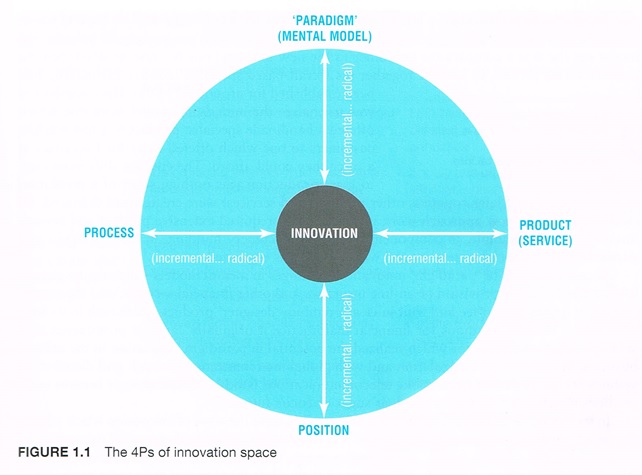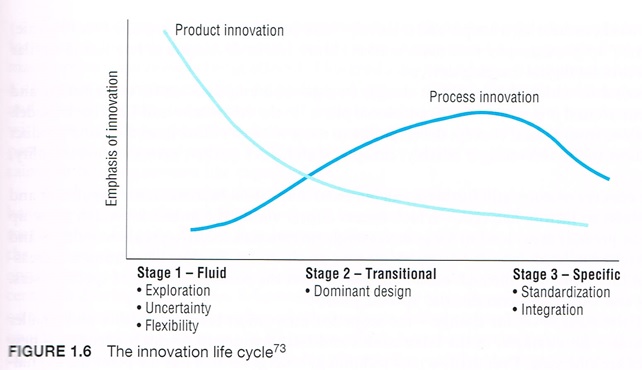Process, Product and Service Innovation
Start
I am thinking of starting this blog a familiar document. Begin by examining the treatment of the subject the book Managing Innovation, written by J. Tidd and J. Bessant, I use a Fifth Edition.
 ISBN 978-1-118-36063-7
ISBN 978-1-118-36063-7
The book to find out very thoroughly innovations from different angles.
The book was also a link to the e-book www.wileyopenpage.com, but I actually got it to work. Remind mentioned limited access to 15 months.
The book also delves into a lot of corporate strategy and innovation, the effects of each other.
Innovations often explained the strategy point of view, as in the following product innovation case.
Examples of production, product and service innovations
New product development is an important capability because the environment is constantly changing. Shifts in the socio-economic field (in what people believe, expect, want and earn) create opportunities and constraints. Legislation may open up new pathways, or close down others - for example, increasing the requirements for environmentally friendly products. Competitors may introduce new products which represent a major threat to existing market positions. In ali these ways firms need the capability to respond through product innovation.
Also, the following example describes well the Japanese industry process innovation.
Japanese dominance in the late twentieth century across several sectors - cars, motorcycles, shipbuilding, consumer electronics - owed a great deal to superior abilities in manufacturing - something which resulted from a consistent pattern of process innovation. Similarly, being able to offer better service - faster, cheaper, higher quality - has long been seen as a source of competitive edge. Citibank was the first bank to offer an automated teller machine (ATM) service and developed a strong market position as a technology leader on the back of this process innovation.
The creation of service innovations is explained in the book advanced electronic data transfer appendage. I think the service innovations often arise from the production of innovations at birth and various reorganisations, outsourcing functions when the need arises for various ancillary services. The next book example of service innovation.
In most economies the service sector accounts for the vast majority of activity so there is likely to be plenty of scope. Lower capital costs often mean that the opportunities for new entrants and radical change are greatest in the service sector. On-line banking and insurance have become commonplace, but they have radically transformed the efficiencies with which those sectors work and the range of services they can provide. New entrants riding the Internet wave have rewritten the rule book for a wide range of industrial games - for example, Amazon in retailing, eBay in market trading and auctions, Google in advertising, Skype in telephony. Others have used the web to help them transform business models around things like low-cost airlines, on-line shopping and the music business.
The 4Ps of innovation space
The book presents The 4Ps of innovation space model. Picture is often presented to illustrate the change in product development and process innovation change. Service innovation and impact on the organization's activities are often also described in The 4Ps of innovation space model.

The 4Ps framework
In the book The Figure 1.2 clearly positions the various innovations on the map, but at the same time to clarify the discrepancy identified in the Process, Product and service innovations States.

The innovation life cycle
The book also stresses the continuity of innovation. To guarantee the continuity shown in reliance on both the production of the product innovations. In this case, the life cycle of innovations can be extended and will allow more time to start the new innovation and product development.
Importantly we need to remember that the advantages which flow from these innovative steps gradually get competed away as others imitate. Unless an organization is able to move into further.

Next book sample
Sorry to all who do not speak Finnish. I try to find the main points of the book production, product and service innovations. I translate them in English if possible.
Innovaattorin opas, Kari Leppälä, Gaudeamus Oy 2014.
 ISBN 978-952-495-326-9
ISBN 978-952-495-326-9
Different types of innovation
The book gives in my opinion, the best unambiguous (although Finnish is often said to be ambiguous language) description of the different types of innovations. It is worth noting that it is brought up already forgotten many of the books of undetected type of innovation, social innovation.
Process innovations
Process innovations dominate the entire industrial action. They can be wide-ranging reforms to improve the production or process-specific insights. Production Innovations have profoundly influenced society. Examples of innovations in the production of manufactories, simple manufacturing machinery, mechanical power transmission, electrical drives added flexibility, automation, robotics, as well as a wide range of thermal, mechanical and chemical processes. Ylesiluonteisimpia insights are, for example, production logistics, conveyor belts and other materialistic stream-based improvements, as well as string theory and optimization.
Product innovation
Product innovation will produce improved or completely new products. Product innovations and process innovations have a strong coupling: new manufacturing methods produce better products in terms of quality and innovative products.
Service innovations
Service innovations can be reached very quickly, and the name suggests, they produce social goods. They can also support and enhance the recovery of material products and distribution. Service innovations are often an integral part of other innovations.
Social innovations ?
Social innovations are reflected in the large numbers of people changing behavior. If an industrial innovation is a strong social component, the innovation may slow down the birth. On the other hand innovation pronounced effect on the behavior of the formative brings high-volume and temporal long-term ambition.
This last innovation
Social innovation I think is very significant, because it can strategically void, or to highlight other types of innovation in the market, as well as influence the diffusion of innovation in the market. Social innovation has roots in the early 1960s, when it was used, for example, an English sociologist and politician Michael Young, an American, Benjamin Franklin and an Englishman Robert Owen also known as the creator of the co-operative action. At the beginning of the social innovation described in the new policies, strategies or organizations, such as schools and libraries. Now if you look at purely social innovation innovation as a species, such as Leppälä it presents, is its impact on R & D and innovation relevant. Social innovation can not even explain the more "unexpected" failures of new innovations disclosing and roll-outs, even though the corresponding case should not talk about the event as "surprising" because the background is a large crowd behavior. The influence of social innovation should speak rather of product development and innovation management, strategic incompetence, because of social innovation is not taken into account.
When we took into account the definition of innovation, degree of innovation, consumers determine which assess the significance of the innovation itself and that it in itself as a growing increase in value of the product. The more the consumer determines a significant increase in the value, the more innovative that product increases. Diffusion increases the number of clients increases. In fact, social innovation works like factor species when compared to other innovation when it comes to marketing and strategy effects. Social innovation, the effects of other innovations, the emergence of a slowdown in the temporal and perseverance, can not stop thinking about information technology or operating systems, competition for market position.
One more
I want to add one other Finnish book. The book mentioned in the above-mentioned social innovation.
Johda innovaatioita, Tiina Apilo - Tapani Taskinen - Iiro Salkari, Talentun Media Oy 2007.
 ISBN 978-952-14-1126-7
ISBN 978-952-14-1126-7
The traditional strategy and management literature has emerged alongside the company's management oriented innovation management literature dealing with. Now, these books raises the balancing of control and chaos. For example, the market leaders often make fatal mistakes by choosing an analytical way the selected innovation strategy, then played with too many eggs in one basket, relying on their own analysis. Brown and Eisenhard recommend Leppälä such as the use of social innovation. By experimenting with the progress, then let the market decide which options are offered, the innovation continues. This was not built as soon as the start of a strategic traditionally process or product innovations on the bottom, but the social component controls the direction of product development.
 In English
In English Suomeksi
Suomeksi




